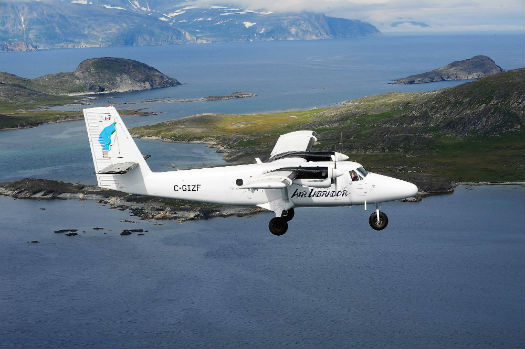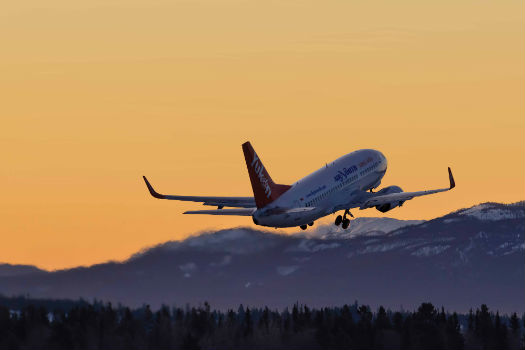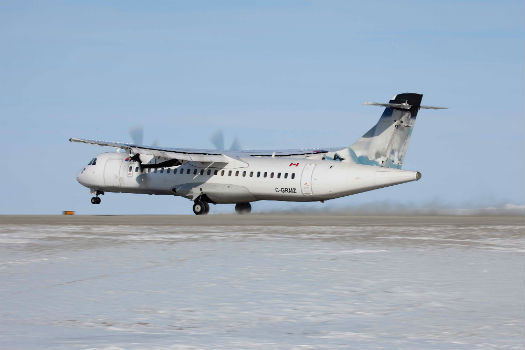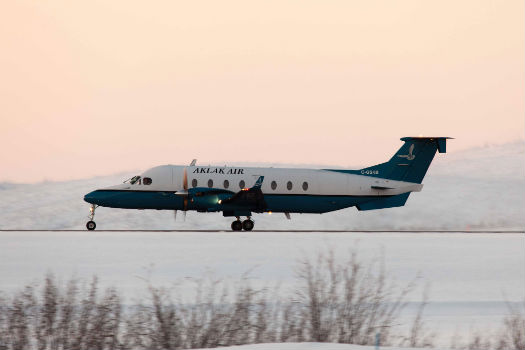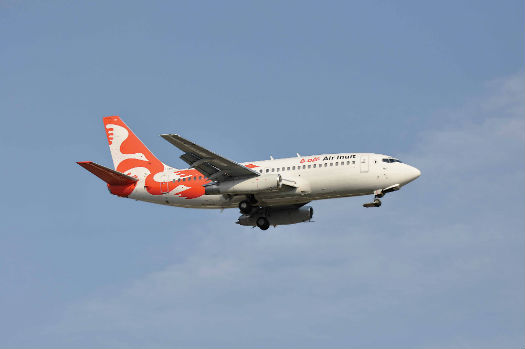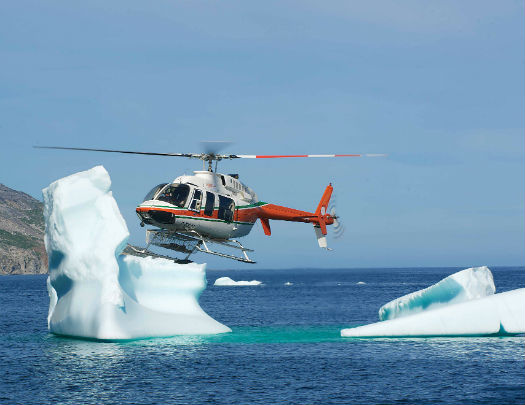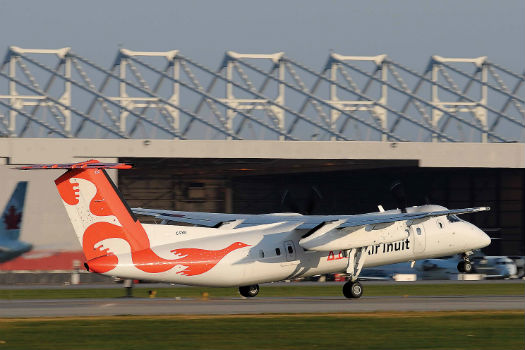In 2012, the Nunatsiavut government (through Nunatsiavut Group of Companies) purchased a 51 per cent share in Air Labrador. Mike Reyno Photo
In the late 1970s, the aboriginal communities in Northern Canada (First Nations, Inuit and Métis) began to create and buy airlines.
Today, the major airlines serving Canada’s three territories and the northern part of four provinces are aboriginal-owned.
The tipping point came in the mid-1970s after the first modern land claim agreements were signed between the Government of Canada and Quebec, providing the aboriginal Cree and Inuit communities with land, money and self-government.
Airline ownership was a natural area of focus for remote communities that were accessible only by air, but which desired to control the cost of living while increasing economic development and long-term employment.
In subsequent years, more land claims were settled. Nunavut was created as a new territory, and aboriginal communities have gained a stake in new natural resource and hydroelectric developments, which have helped fund new aviation investments.
“Airline investment has allowed the aboriginal communities to control their own destiny and has been reasonably successful,” commented Stephen Nourse, executive director of the Northern Air Transport Association (NATA).
Besides facilitating traffic and northern tourism, Air North’s expansion has created 500 airline jobs, which brings many long-term benefits to the North. Simon Blakesley Photo
BY THE NUMBERS
Today, there are 19 northern Canadian air carriers that are fully or partially-owned by aboriginal communities. Their route networks cover more than half the Canadian land mass and a region that is one of the most sparsely populated on the globe.
The eight wholly-owned airlines include Air Creebec (owned by Creeco Inc., representing the Quebec Cree); Air Inuit and First Air (both owned by Makivik Corp., representing the Quebec Inuit); Canadian North (owned by NorTerra Inc., representing the Inuvialuit of the Western Arctic); Missinippi Airways (owned by Mathias Colomb Cree Nation); Wasaya Airways (owned by 10 First Nation communities located in Northwestern Ontario); Northern Skies Air Service (owned by four Ontario communitries through CreeWest GP of Timmins, Ont.); and Bamaji Air Inc. (Wasaya Group and Slate Falls First Nation).
The remaining partially-owned air services include Air Labrador (Nunatsiavut Group of Companies), Universal Helicopters (Nunatsiavut Group of Companies, Tasiujatsoak Trust and CAPE Fund), and Innu Mikun Airlines (Innu Development Ltd. and Provincial Air Lines) in Newfoundland and Labrador; Innukopters (la Société de Gestion Ekuanitshinnuat) and Nunavik Rotors (Quebec Inuit) in Quebec; West Wind Aviation and its subsidiary Pronto Airways (Meadow Lake Tribal Council, Prince Albert Development Corp. and Athabasca Basin Development) in Saskatchewan; Aklak Air (Inuvialuit Development Corp. and Kenn Borek Air) and North-Wright Airways (Deline Land Corporation, Yamoga Land Corporation, and Norman Wells Claimant Corporation) in the NT; and Air North, Yukon’s Airline (Vuntut Development Corp.) in the Yukon.
A First Air ATR 72 lands on a gravel runway. The ATR was first introduced as a replacement for the Hawker Siddeley HS 748. Today, First Air flies 11 ATR aircraft. Jason Pineau Photo
At the time of writing, these companies were collectively flying a combined fleet of 220 aircraft.
Discovery Air’s Great Slave Helicopters and Air Tindi collectively have joint ventures with more than 20 aboriginal communities across the NT, Nunavut, Alberta and British Columbia and other operators have similar regional partnerships.
That’s not to say that all aboriginal-owned airlines have been sustainable, with airline closures since the early 1990s including Waglisla Airlines and Tyee Airways in BC, Little Red Air Service and Contact Airways in Alberta, Nunasi Northland Airlines of Manitoba, NAC and Sabourin Lake Airways in Ontario, and Air Wemindji in Quebec.
Based in Inuvik, NT, Aklak Air’s scheduled network serves small Inuvialuit communities with 100 to 200 people. Jason Pineau Photo
NORTHERN CHALLENGES
Lack of federal aviation infrastructure spending means that only five major airports in Northern Canada have paved runways, compared to Alaska where most runways are paved. This forces northern operators to make costly investments in gravel-capable aircraft and other facilities to serve small communities, with this cost partially covered by revenues they generate flying to southern markets, said John McKenna, president of the Air Transport Association of Canada (ATAC).
“When Air Canada or WestJet fly into Whitehorse or Yellowknife and start a price war, they effectively undermine the business of northern-based airlines that provide significant local employment and provide the only year-round air service to dozens of remote communities,” explained a long-time northern airline observer.
Service to northern communities could also be affected by the proposed plan to reduce the length of their runways to accommodate the addition of overrun areas, since funding for extensions is non-existent. Industry observers say the regulation change, if introduced, could reduce the passengers and cargo carried on existing flights, which will undercut the profitability of regional carriers.
Joe Sparling, president of Air North, said that investment by the Vuntut Development Corp. and other Yukon residents has allowed Air North to add Boeing 737s in 2002, and extend its network to Yellowknife and five southern gateways, including Ottawa. Besides being good for traffic and northern tourism, business expansion also created 500 airline jobs, which brings many long-term benefits to the north.
Northern airlines fly not only business and leisure passengers plus essential cargo, but also a community’s fresh food as well as patients requiring treatment in urban centres.
“Aboriginal ownership leads to a different kind of airline business model,” said Brock Friesen, president of First Air. “You have a business obligation to make a profit for your stakeholders (corporate owners) in order to support the acquisition of new aircraft, but you also provide an essential service to the northern communities which represent your passengers and some of your employees.”
Air Inuit inaugurated Boeing 737-200C ‘combi’ service in 2007 from Montreal to Puvirnituq, which has become a passenger/cargo hub for Inuit villages on the northeast coast of Hudson Bay. Ken Swartz Photo
NEW AIRLINES
The first aboriginal-owned airlines were founded by entrepreneurial bush pilot Fred Carmichael of Aklavik, NT (Reindeer Air Service in 1959) and Johnny May from George River (Kangiqsualujjuaq), Quebec (Johnny May’s Air Charters in 1974).
In the 1970s, important court victories upheld historic treaty rights and changed government attitudes toward negotiating aboriginal land claims.
After the James Bay and Northern Quebec Agreement (JBNQA) was settled in 1975 between the federal and Quebec governments and the Inuit, Cree and Naskapi peoples, aboriginal groups began to focus on economic development. Both the Cree and Inuit communities announced plans to enter the airline business as part of their strategies. As the primary consumers of air services in their respective regions, this marked the beginning of a new chapter in Canadian airline history.
“We entered the airline industry in order to control our own destiny,” said Pita Aatami, president of Air Inuit and a past president of Makivik Corp. “The 12,000 Inuit people of Nunavik live in 15 villages along the Ungava Bay, Hudson’s Straight, and Hudson’s Bay coasts, in a territory that is larger than France. It’s very expensive to live there because none of our communities are connected by roads and they only receive cargo by sea in summer.
“Community ownership has provided us with a way to control our cost of living and stimulate aboriginal employment,” he continued. “We’re always trying to find new ways to reduce transportation costs and we’re constantly talking to our people to understand what they need.”
West Wind Aviation’s four ATR 42s are dedicated to transporting crews to mining operations. Pat Gould Photo
Today, Air Inuit flies 25 aircraft, ranging in size from King Air A100s to Boeing 737-200C combi jets.
“We don’t have the population base to operate a full cargo or full passenger aircraft, so a combi aircraft makes the most sense,” said Aatami. Air Inuit was one of the first carriers to introduce Dash 8-300 “combi” (cargo/passenger) aircraft that were outfitted with a moveable bulkhead.
Since 1991, the airline has also flown for Hydro Quebec, facilitating crew changes at hydroelectric generating sites in the north.
Air Inuit has also made good progress raising aboriginal employment, including pilots. This past summer, it even established a flying school in Kuujjuaq to stimulate career interest.
In 1990, Makivik bought First Air to carry passengers and cargo from the south to Air Inuit’s hub in Kuujjuaq. The acquisition followed the consolidation of the Canadian airline industry in the late 1990s and was motivated by a desire to reduce passenger fares and cargo rates to the North.
Under Makivik ownership, First Air expanded westwards to Yellowknife, buying Ptarmigan Airways in 1995 and NT Air from Air Canada in 1997, which introduced both the Boeing 737-200C combi and Lockheed Hercules into the merged fleet.
“First Air serves two markets today,” explained Brock Friesen, the airline’s president. “The largest part of our business is scheduled passenger and cargo flights, and the other part is charter flights serving natural resource industries such as mining.
“Most of the cargo on our scheduled flights is food that we fly up from southern gateways in Montreal, Ottawa, Winnipeg and Edmonton to our northern hubs in Rankin Inlet and Iqaluit, or that is transported by road to Yellowknife for onward distribution to smaller communities, using our ATR turboprop fleet.”
Founded in 1963, Universal Helicopters Newfoundland Ltd. was acquired in 2013 by Nunatsiavut Group of Companies, Tasiujatsoak Trust and CAPE Fund. Mike Reyno Photo
Friesen said the scheduled side of the business is very stable, because the airline provides an essential service that includes medical transfers, business and flights for VFR (visiting friends and relatives). However, the charter side of the operation has become quieter in the past few years, as activity in the mining sector slows.
“One of the biggest challenges of operating an airline in northern Canada is the low asset utilization,” said Friesen. “There are only 60,000 people in the NT and Nunavut, and most communities are so small that they don’t require more than one flight a day. It’s very hard to achieve the high utilization rates and low unit costs of a WestJet in Canada or a low-cost carrier in Europe.
“Our business philosophy is to give back to the communities we serve, not so much in a charitable way but by utilizing local resources, including people, as much as possible,” he continued. “About 26 per cent of our employees are Inuit and this includes pilots and flight attendants, and we draw on local people with the right education.”
Starting in 2010, First Air began establishing transportation service agreements with northern aboriginal development Corp.s such as Qikiqtaaaluk Corp., to create Qikiqtani First Airlines as a marketing tool and to help increase Inuit participation in its business.
In recent years, Boeing 737-200Cs replaced Boeing 727s and ATR42/72s replaced HS748 turboprops because of the increased cost of flying older equipment, including high fuel burn, elevated maintenance costs and diminished reliability.
More recently, First Air introduced two Boeing 737-400 combi aircraft to its fleet of 23 aircraft, the first of this version to fly in northern Canada.
Pronto’s Beech 1900C initially linked a number of northern Saskatchewan destinations, and was extended north to the Nunavut communities of Rankin Inlet and Baker Lake in 2008. West Wind Aviation Photo
“The 737-400 combi is much more reliable and much more fuel efficient than a 40-year-old 737-200, and has more capacity. We still operate three 737-200 combi’s to serve larger airports with gravel runways, such as Resolute Bay and Cambridge Bay, and our ATR42s and ATR72s serve smaller communities with gravel runways,” concluded Friesen.
Another major player in the northern airline market is Canadian North, a subsidiary of NorTerra Inc., a management and holding company 100 per cent owned by the Inuvialuit Development Corp. (IDC). (Its holdings also include 51 per cent of Aklak Air and 51 per cent of Aklak Canadian Helicopters.)
Canadian North and its founding companies – Canadian Airlines, Pacific Western Airlines, Transair and Nordair–have served Canada’s north with passenger and cargo services for more than 80 years. In September 1998, it was purchased by NorTerra Inc.
The airline has more than doubled in size in recent years, due to growing northern and eastern routes, and especially the expansion of its Boeing 737 charters, including oil sands crew changes, leisure charters for cruise ship operators, and contracts to fly CFL football teams.
Today, Canadian North has over 900 employees and operates 20 aircraft. Its Boeing 737-200s are equipped with gravel kits for operation from unpaved runways, while the 737-300s serve paved airports in the network as well as a growing charter business.
“We will also be unveiling a 737-300 combi aircraft as part of our ongoing fleet renewal program,” said Steve Hankirk, president of Canadian North. “This will be the first 737-300 to operate as a combi anywhere in the world.”
North-Wright Airways operates 23 aircraft, including this Beech 1900D serving communities from Yellowknife to Inuvik. A majority stake in the airline is held by three aboriginal corporations. Sue Coyne Photo
OTHER ABORIGINAL-OWNED AIRLINES
Aklak Air of Inuvik, NT, provides scheduled service to Inuvialuit communities in the Western Arctic and charters for industry.
“Our scheduled network serves small Inuvialuit communities with 100 to 200 people, located up to 415 statute miles away, and our charter business includes some natural resource, corporate, government and tourist work,” said Ken Dalton, general manager of Aklak Air.
During the peak summer season, the airline operates a Beech 1900D, two DHC-6-300 Twin Otters, and two King Air 200s.
“We added the 1900D two years ago and it was a great addition for our scheduled routes. There has been a lull the last few years in the oil and gas charter market, but we’re flying more tourists who drive north on the Dempster Highway to Inuvik and want to see the Arctic Ocean,” added Dalton.
Aklak Air is locally managed, with aircraft, pilots and AMEs supplied by Kenn Borek Air. Its board of directors includes representatives from the Inuvialuit Regional Corp. and Kenn Borek Air.
Inuvialuit Regional Corp. is also a partner in Aklak Canadian Helicopters based in Inuvik, and has participated in oil and gas projects including offshore support to seismic survey vessels mapping the Beaufort Sea for an expected resumption in Arctic offshore drilling.
When Air Creebec was launched 32 years ago in Val-d’Or, Que., president Matthew Happyjack told Skies that its first goals included providing a more reliable air service, controlling the cost of tickets, and linking the Inland Cree and Coastal Cree communities with direct flights so passengers did not have to connect through Montreal airport.
Today, the airline has grown from 14 employees and one Twin Otter in 1982, to official 2012 statistics of 350 employees and 19 aircraft, with 110,000 passengers and hundreds of tons of cargo flown annually.
“Scheduled service accounts for 45 per cent of our business, contract work for another 45 per cent, and our remaining revenues come from fuel sales, retail sales and renting space in our new hangar at Montreal’s Trudeau airport,” explained Happyjack.
“From Montreal, we fly contract flights to the Eastmain 1 hydroelectric generating station using a Dash 8-300 chartered to Hydro Quebec; and from Timmins, Ont., we fly Dash 8s and HS748 freighters to De Beers’ Victor diamond mine, which is accessible only by air and a winter road.”
Canadian North has flown passengers and cargo for more than 80 years. In September 1998, it was purchased by NorTerra Inc. Jason Pineau Photo
Happyjack said Air Creebec’s revenues have increased 33 per cent since 2010, and the airline continues to seek more contract work to further grow revenues and to help support its scheduled services to villages that are only accessible by air.
“One of our major challenges is that the population is rapidly growing in the Cree communities where the gravel runways are only 3,500 feet long,” he said. “Transitioning to a larger aircraft like a Dash 8-300 makes economic sense to accommodate the growth and to help offset the high cost of fuel, but the runways are too short to fly with a full load when the surface is contaminated by snow.”
Elsewhere, Air Creebec has had good success increasing local employment, with 30 per cent of its employees from First Nations communities including 35 of its 100 pilots.
Another notable player in Northwestern Ontario is Wasaya Airways, formed in 1989 and headquartered in Thunder Bay, Ont. The airline has a registered fleet of 22 aircraft, including five Cessna 208B Caravans, six Pilatus PC-12s, seven Beech 1900Ds, one Dash 8-100 and three HS748 turboprops used to fly cargo and fuel. The Wasaya Group is also a partner with the Slate Falls First Nation in Bamaji Air, a floatplane operator based in Sioux Lookout.
Missinippi Airways (also known as Beaver Air Service) is owned by Mathias Colomb Cree Nation in Northern Manitoba. It serves Pukatawagan, a remote community that has no road to the outside world, but is linked to the south by a rail line that carries passengers and freight. The airline operates a fleet of nine aircraft.
Combi aircraft make the most sense for Air Inuit, which doesn’t have the population base to operate a full cargo or full passenger aircraft. Eric Dumigan Photo
ABORIGINAL AIRLINE PARTNERSHIPS
Warren and Carolyn Wright founded North-Wright Airways in the mid-1980s. From its headquarters in Norman Well, NT, the airline serves communities from Yellowknife to Inuvik and communities along the Mackenzie River
with its fleet of 23 aircraft. A majority stake in the company is held by the Deline Land Corp., the Yamoga Land Corp., and Norman Wells Claimant Corp.
Founded as a corporate charter company in 1982, West Wind Aviation is 80 per cent First Nations owned. It offered scheduled passenger service between Regina and Saskatoon in the fall of 2004, operating as Express Air and flying two Jetstream 31s between its Shell Aerocentre FBOs in the two cities. West Wind extended its scheduled passenger service to Northern Saskatchewan in February 2006 with the launch of Pronto Airways, an airline in which it has a major ownership interest and to which it provides aircraft, pilots and maintenance. Pronto’s Beech 1900C initially linked Saskatoon, Prince Albert, Points North, Wollaston Lake, Stony Rapids, Uranium City and Fond du Lac, and in 2008 was extended north to the Nunavut communities of Rankin Inlet and Baker Lake. In 2010, 25 per cent of Pronto Airways was acquired by the Black Lake Denesuline First Nation, which is served by Stony Rapids Airport. Saskatchewan is the world’s second-largest uranium producer, and West Wind Aviation’s four ATR 42s are dedicated to transporting crews to mines operated by companies such as AREVA and Cameco.
Serving the Labrador coast, Innu Mikun Airlines is operated by partners Provincial Airways and the Innu Development Limited Partnership. Also in Labrador, it was announced in 2012 that the Nunatsiavut government (through Nunatsiavut Group of Companies) had purchased a 51 per cent share in Air Labrador, and the group (with other partners) also bought Universal Helicopters of Goose Bay, NL, in late 2013.
Discovery Air’s Great Slave Helicopters (GSH) and Air Tindi have the most extensive network of regional aboriginal partnerships, with new partnerships formed recently in B.C., along proposed gas and oil pipeline right-of-ways. GSH has a corporate mission to “contribute to the economic development of aboriginal people” and it provides aboriginal employment opportunities with internships and mentoring programs. The company employs a full-time aboriginal relationships administrator to oversee the multi-faceted agreements and the success of the partnerships has led to multiple aboriginal-owned aircraft in its fleet, including Airbus Helicopters AS350 B2s and BK-117s and a de Havilland Dash 7 flying with Air Tindi.
Partnerships such as these are not uncommon in today’s aviation landscape. The Canadian North is vast and sparsely settled, and isolation is the common denominator for its communities. Realizing that without a dependable and affordable air link many settlements would cease to exist, the country’s aboriginal groups have moved decisively to establish themselves in the airline market. Despite infrastructure challenges and escalating costs, they continue to link communities to the necessities of life, and their advent forever changed the Canadian airline landscape.
